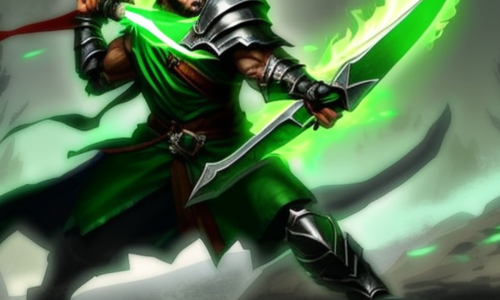Fall damage is a crucial aspect of the game mechanics in Dungeons and Dragons 5th Edition. When a character falls from a height, they may take damage, and this can have a significant impact on their survival and success in the game.
Therefore, it is essential for players to understand the rules and strategies related to fall damage in order to make informed decisions and stay alive.
In this essay, we will provide an overview of the rules and mechanics of fall damage in D&D 5e, as well as the ways in which players can avoid or mitigate its effects.
We will also discuss the role of fall damage in creating a sense of realism and danger in the game, and how it contributes to the overall experience of playing D&D.
For example, if a character falls 30 feet, they will take 3d6 bludgeoning damage. If they fall 100 feet, they will take 10d6 bludgeoning damage. And if they fall 200 feet or more, they will take the maximum amount of fall damage possible, which is 20d6.
We will examine the impact that falls damage can have on player choices and strategies, and how it can affect the balance of power between different types of characters.
By understanding the significance of fall damage in D&D 5e, players can develop a deeper appreciation for the game’s mechanics and dynamics, and make more informed decisions that help them achieve their goals.
We will also explore some of the nuances and details of fall damage in 5e, such as the fact that it is always bludgeoning damage and cannot be resisted by armor.
However, there are ways to avoid or mitigate fall damage in D&D 5e. Certain spells and abilities, such as Feather Fall or the Monk’s Slow Fall ability, allow characters to reduce or negate the amount of fall damage they take.
Additionally, characters who can fly or who have access to levitation spells can avoid fall damage altogether.
Understanding Fall Damage in D&D 5e
Dungeons and Dragons 5th Edition (D&D 5e) is a popular tabletop role-playing game that has been enjoyed by millions of players worldwide. In the game, players create their own characters and embark on epic adventures filled with danger, treasure, and magic.
One aspect of the game mechanics that players must be aware of is fall damage, which is a type of damage that a character may suffer when they fall from a height.
In D&D 5e, fall damage is calculated based on the distance fallen. For every 10 feet a character falls, they take 1d6 bludgeoning damage, up to a maximum of 20d6. This means that if a character falls 200 feet or more, they will take the maximum amount of fall damage possible.
It is important for players to be aware of the rules surrounding fall damage, as it can have a significant impact on their character’s survival and success in the game.
A character who takes too much fall damage may be killed or incapacitated, which can have serious consequences for the player’s ability to progress through the game.
There are, however, ways to avoid or mitigate fall damage in D&D 5e. Certain spells and abilities, such as Feather Fall or the Monk’s Slow Fall ability, allow characters to reduce or negate the amount of fall damage they take.
Additionally, characters who can fly or who have access to levitation spells can avoid fall damage altogether.
Fall damage is also an important part of the game’s realism and immersion. The inclusion of fall damage adds an element of risk and uncertainty to the game, forcing players to carefully consider their actions and decisions.
It can also create dramatic and exciting moments in the game, such as when a character narrowly avoids falling to their death.
In conclusion, understanding fall damage is an important aspect of playing D&D 5e. By being aware of the rules and strategies related to fall damage, players can make informed decisions and avoid unnecessary risks.
Additionally, the inclusion of fall damage adds a sense of realism and danger to the game, creating a more immersive and exciting experience for players.
How to Calculate Fall Damage explain
In D&D 5e, fall damage is calculated based on the distance a character falls. For every 10 feet a character falls, they take 1d6 bludgeoning damage, up to a maximum of 20d6. Here’s how to calculate fall damage in D&D 5e:
Determine the height from which the character is falling. This can be done by measuring the distance in feet from the character’s starting point to their landing point.
Divide the height by 10. Round down any fractions. This will give you the number of d6s to roll for fall damage.
Roll the appropriate number of d6s and add up the results. This will give you the total amount of bludgeoning damage the character takes from the fall.
For example, if a character falls 50 feet, you divide 50 by 10 to get 5. This means the character takes 5d6 bludgeoning damage from the fall. Roll 5 six-sided dice and add up the results to determine the total amount of damage.
It’s important to note that fall damage is a type of bludgeoning damage and is subject to resistance or vulnerability to bludgeoning damage. Some spells, abilities, or magic items may also modify the amount of fall damage a character takes or reduce it to zero.
Calculating fall damage is a simple process that involves dividing the height of the fall by 10 and rolling the appropriate number of d6s to determine the amount of bludgeoning damage a character takes.
Exceptions to Falling
In D&D 5e, falling is a common hazard that characters may encounter during their adventures. However, there are some exceptions to falling that players should be aware of. Here are a few examples:
Flying characters: Characters who can fly, such as those with wings or access to the Fly spell, are immune to fall damage since they are not technically falling. They can fly safely down to the ground from any height.
Feather Fall spell: The Feather Fall spell is a 1st-level spell that allows up to five creatures to fall safely from any height. The spell slows the descent of the creatures and allows them to take no fall damage.
Slow Fall ability: Monks have a class ability called Slow Fall, which allows them to reduce fall damage by an amount equal to five times their monk level. This ability can be used as a reaction when falling to reduce the amount of damage taken.
Landing in water: If a character falls into a body of water, the fall damage is reduced to a maximum of 20 points, regardless of the height of the fall.
Magic items: Some magic items, such as the Winged Boots or the Ring of Feather Falling, provide characters with the ability to fly or reduce fall damage.
Climb speed: Some characters may have a climb speed, allowing them to move up or down vertical surfaces without falling. For example, a spider climb spell grants a creature a climb speed and can prevent them from falling.
Levitate spell: The Levitate spell allows the target to float in the air and move horizontally, but not vertically. The spell does not prevent a character from falling if they are moved by an outside force, such as a gust of wind or a spell that knocks them prone.
Jump spell: The Jump spell allows the target to jump higher and farther than they normally could, potentially allowing them to avoid fall damage by jumping to safety.
Parachute or other equipment: Characters may be able to use equipment such as a parachute, rope, or grappling hook to slow their descent and reduce fall damage. These items are not always readily available, but creative players may be able to improvise and find a way to use what they have on hand to reduce fall damage.
Fall damage is an important part of D&D 5e that adds risk and excitement to encounters involving heights and falling.
By understanding the rules and exceptions surrounding fall damage, players and DMs alike can create engaging and memorable experiences that keep everyone on the edge of their seats.
Strategies for Avoiding or Mitigating Fall Damage
In D&D 5e, fall damage can have a significant impact on a character’s survival and success in the game. However, there are ways to avoid or mitigate fall damage. Here are some strategies for avoiding or mitigating fall damage in D&D 5e:
Use Spells or certain abilities such as Feather Fall and Slow Fall, allowing characters to reduce the amount of fall damage they take. The Monk class also has an ability called Slow Fall, which allows them to reduce fall damage by a certain amount based on their level.
Use items or equipment that reduce fall damage. Some magic items, such as the Winged Boots, allow characters to fly or glide, which can help them avoid fall damage altogether. Other items, such as the Ring of Feather Falling, reduce the amount of fall damage a character takes.
Avoid falling altogether. Characters who can fly or who have access to levitation spells can avoid fall damage altogether by simply not falling. Other characters can use abilities such as the Spider Climb spell to climb down from a height instead of jumping or falling.
Use terrain to break a fall. In some cases, characters may be able to use terrain to break their fall and reduce the amount of fall damage they take. For example, a character who falls into a body of water or lands on a soft surface such as a pile of hay or snow may take less fall damage than if they had landed on a hard surface like stone or metal.
Overall, there are a variety of strategies that characters can use to avoid or mitigate fall damage in D&D 5e. By using spells, abilities, items, or terrain to their advantage, characters can reduce the amount of fall damage they take and increase their chances of survival in the game.
The Role of Fall Damage in D&D 5e
The role of fall damage in D&D 5e is to add an element of risk and danger to the game while also providing players with opportunities to strategize and use their abilities to avoid or mitigate fall damage.
Fall damage is an important aspect of the game mechanics in D&D 5e, as it can have a significant impact on a character’s survival and success in the game. Characters who take too much fall damage may be killed or incapacitated, which can have serious consequences for the player’s ability to progress through the game.
Fall damage also provides players with opportunities to strategize and use their abilities to avoid or mitigate fall damage. By using spells, abilities, items, or terrain to their advantage, characters can reduce the amount of fall damage they take and increase their chances of survival in the game.
In addition, fall damage can also play a role in the narrative and storytelling aspects of the game. Falling from a great height can be a dramatic and memorable moment in a campaign, and the consequences of fall damage can have lasting effects on a character’s physical and emotional state.
Overall, fall damage serves an important role in the game mechanics, strategy, and storytelling of D&D 5e, adding an element of risk and danger to the game while also providing opportunities for players to use their abilities and creativity to overcome obstacles and succeed in the game.
Homebrew Interference
In tabletop role-playing games such as Dungeons & Dragons, homebrew interference refers to a situation where a player or Dungeon Master (DM) introduces custom rules, mechanics, or content that is not part of the official game rules. Homebrew interference can take many forms, ranging from minor tweaks to major additions that significantly alter the gameplay experience.
Here are some examples of homebrew interference in Dungeons & Dragons:
Custom rules: A DM may introduce house rules that modify the official rules of the game. For example, they may increase or decrease the difficulty of certain actions or alter the way spells or abilities work.
Custom items: A player or DM may create custom magical items that are not in the official game rules. For example, they may invent a powerful sword that can cast a spell when it hits an enemy.
Custom races or classes: A player or DM may create custom races or classes that are not part of the official game rules. For example, they may create a race of half-elves with unique abilities or a class of monks that specialize in unarmed combat.
Custom settings: A DM may create a custom setting that is not part of the official game lore. For example, they may make a world where magic is outlawed and players must hide their abilities from the authorities.
Homebrew interference can add a lot of creativity and personalization to a game, allowing players to tailor their experience to their preferences.
Repercussions of Falling
Falling can have serious repercussions in both real-life and fictional settings such as video games or tabletop role-playing games. Here are some examples of the potential repercussions of falling:
Physical injury: Falling from a height can cause physical injuries such as broken bones, bruises, or even death. The severity of the injury depends on the height of the fall, the surface landed on, and the physical condition of the person falling.
Psychological trauma: Falling can also cause psychological trauma, especially if the fall is unexpected or traumatic. This can lead to fear of heights or anxiety in situations where falling is a risk.
Equipment damage: In certain situations, falling can damage or destroy equipment such as tools, weapons, or vehicles. This can have a significant impact on a character’s ability to complete tasks or continue on an adventure.
Time loss: Falling can also cause a delay or loss of time, as the character may need to recover from injuries or take time to repair damaged equipment. This can be particularly challenging in situations where time is of the essence, such as in a time-sensitive quest or mission.
Reputation damage: In some fictional settings, falling can also damage a character’s reputation or stand among their peers. For example, a knight who falls off their horse in a jousting competition may be seen as less honorable or skilled by their peers.
Environmental damage: In some cases, falling can cause environmental damage to the area around the impact site. For example, falling rocks or debris can cause damage to the environment or structures, leading to potential consequences for the characters or their allies.
Loss of resources: Falling can also lead to a loss of resources, such as the loss of valuable items or equipment that may have been dropped during the fall. This loss can hinder the character’s ability to complete their goals or quests, forcing them to find alternate solutions.
Interference with progress: Falling can also interfere with the character’s progress toward their goals, as they may need to take time to recover or find a way to overcome any resulting obstacles. This can lead to delays or setbacks in the character’s journey.
Negative impact on allies: Falling can also have a negative impact on allies or companions who may witness the fall or be affected by its consequences. This can cause emotional distress or even damage the relationships between the characters, depending on the severity of the fall and its aftermath.
FAQs
What if a character falls less than 10 feet? detail answer
If a character falls less than 10 feet in Dungeons and Dragons 5th Edition (5e), they do not take any damage from the fall. However, the DM (Dungeon Master) may rule that the character still suffers some other type of effect or damage, depending on the situation. For example, the DM might rule that the character takes damage if they fall onto a surface that is particularly hazardous, such as spikes or lava. Alternatively, the DM might rule that the character is knocked prone upon landing, which would use up some of their movement to stand up on their next turn. It’s important to note that the 10-foot threshold for fall damage is a hard rule in 5e, so even if a character falls 9 feet and 11 inches, they will still not take any damage from the fall. This is intended to simplify the game mechanics and make it easier for players and DMs to determine when fall damage applies.
What if a character falls onto a creature?
If a character falls onto a creature in Dungeons and Dragons 5th Edition (5e), the DM (Dungeon Master) must determine what happens based on the circumstances of the fall and the characteristics of the creature. There is no official rule for falling onto a creature, so the DM must use their discretion to determine the outcome.
Here are some possible scenarios for falling onto a creature
The creature breaks the character’s fall: If the creature is large or sturdy enough to support the character’s weight, the DM might rule that the character takes no damage from the fall. For example, if the character falls onto the back of a dragon or the shell of a giant tortoise, they might be able to cling onto the creature and avoid taking damage.
The creature cushions the character’s fall: If the creature is soft or squishy, the DM might rule that the character takes less damage than they would from falling onto a hard surface. For example, if the character falls onto a pile of giant slimes, they might take reduced damage and become restrained in the slimes.
The character collides with the creature: If the creature is too small or weak to support the character’s weight, the DM might rule that the character takes the full amount of fall damage and also takes damage from colliding with the creature. For example, if the character falls onto a goblin, they might take bludgeoning damage from the fall and piercing damage from the goblin’s weapons
The creature grapples the character: If the creature is capable of grappling, the DM might rule that the creature automatically grapples the character upon impact. For example, if the character falls onto a giant spider, the spider might immediately grapple the character with its sticky webbing
The creature moves out of the way: If the creature is able to move quickly, the DM might rule that the creature dodges out of the way of the falling character. For example, if the character falls onto a horse that is being ridden by another character, the horse might jump out of the way to avoid being crushed.
What happens if a character falls more than 200 feet in 5e?
A: According to the 5e rules, a character takes the maximum fall damage of 20d6 if they fall more than 200 feet. This means that no matter how far they fall beyond that point, they will still only take 20d6 damage.
Can a character jump off a cliff and land on an enemy to deal damage in 5e?
No, a character cannot jump off a cliff and land on an enemy to deal damage in 5e. The game’s rules do not allow a character to use their own falling body as an attack, and they automatically miss any target they try to land on. The Player’s Handbook (page 185) states that falling is considered “bludgeoning damage,” which implies that the damage is the result of the character’s body hitting the ground with force, not from the character landing on something else. Even if a character could somehow land on an enemy, they would not be able to deal damage with their body alone. In 5e, characters need weapons or spells to deal damage to enemies, and landing on an enemy with their body would not qualify as an attack.
It is worth noting that attempting to jump off a cliff to land on an enemy would be a very risky and potentially lethal move for the character. Even if they survived the fall, they could suffer other injuries or impairments from the impact, and they would be vulnerable to counterattacks from the enemy and other foes in the area. In short, attempting to land on an enemy by jumping off a cliff is not a viable strategy in 5e, and could result in serious consequences for the character.
Can a character take fall damage from a magical teleportation or displacement effect in 5e?
No, a character does not take fall damage from magical teleportation or displacement effects in 5e. These effects allow a character to move instantly from one location to another, without physically falling or landing








